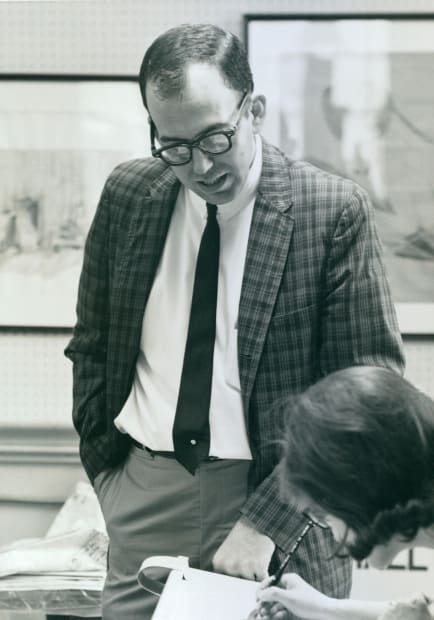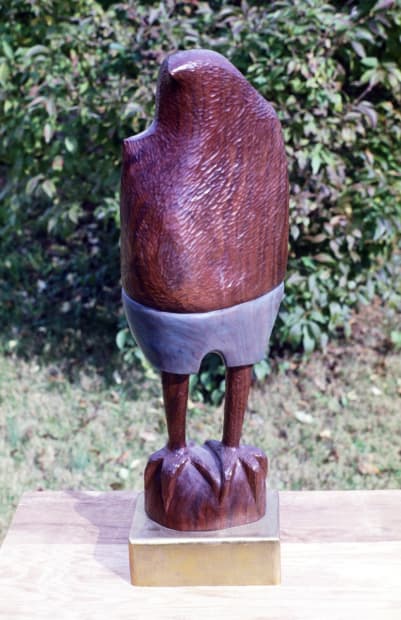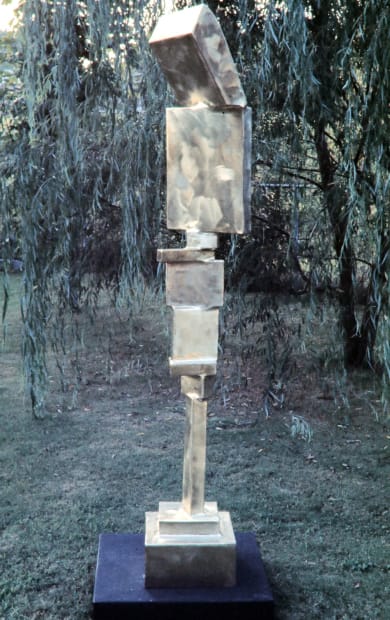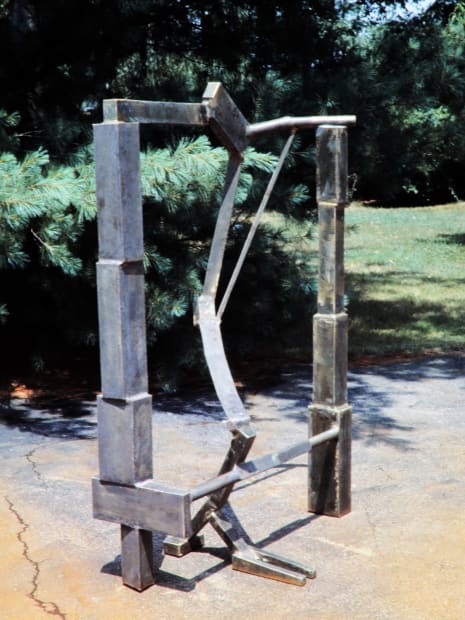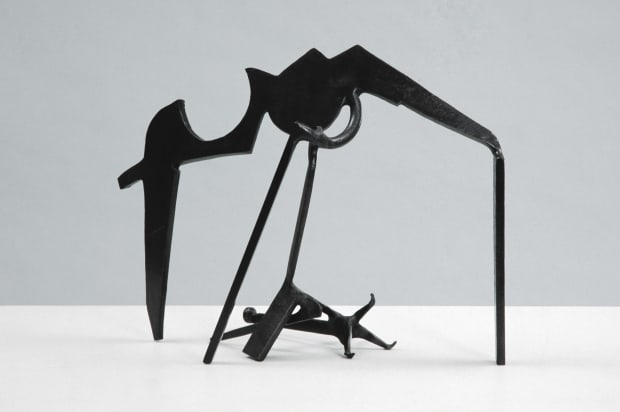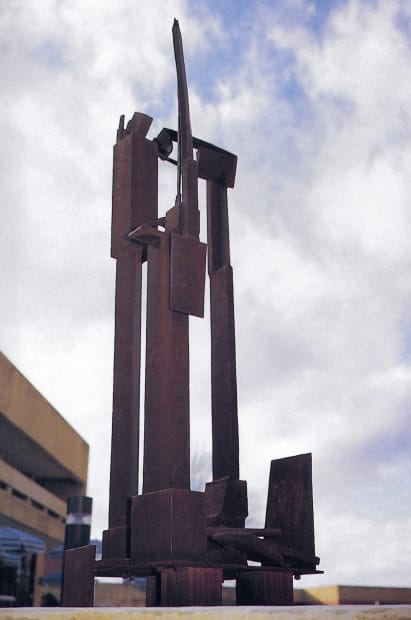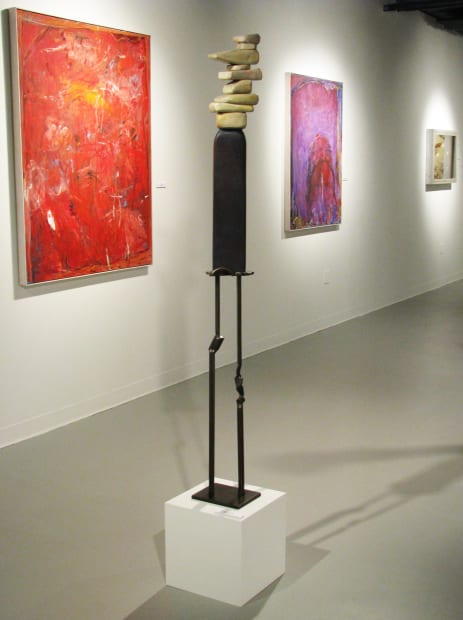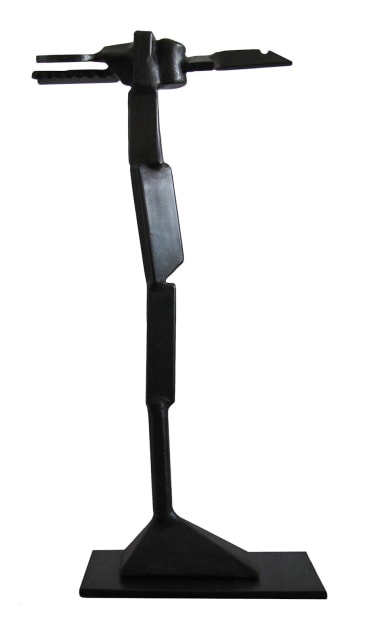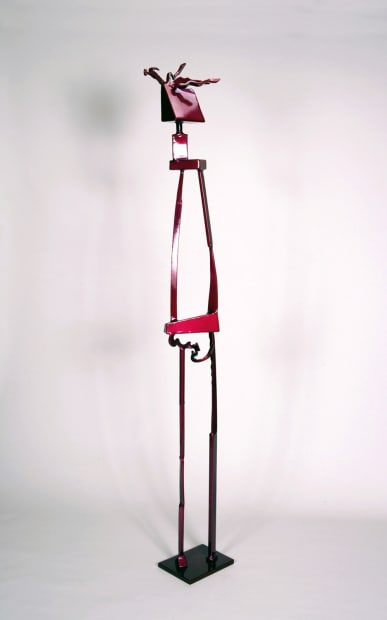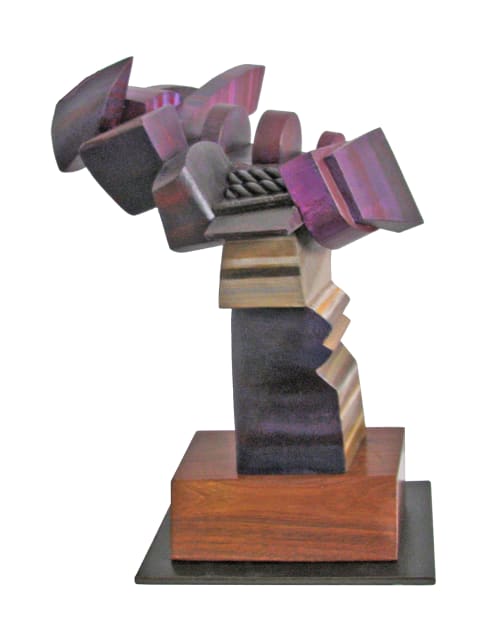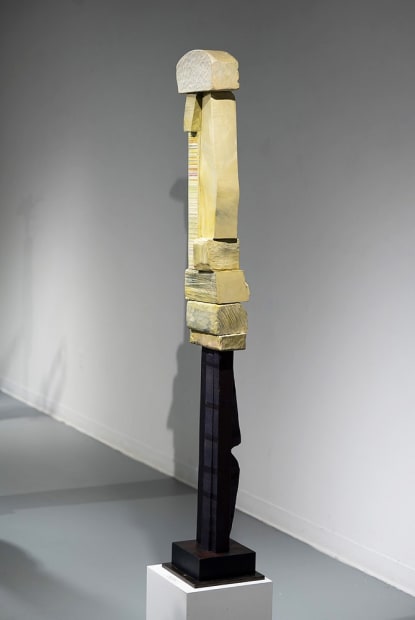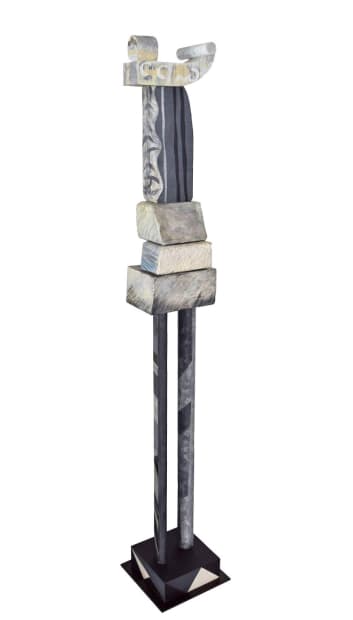-
-
60 Years of Sculpture
-
 Teaching at Morris Harvey College (1966)
Teaching at Morris Harvey College (1966)Early Years as Artist-Teacher
James S. Gibson was born in 1937 in Charleston, West Virginia. He earned two bachelor’s degrees, a Bachelor of Fine Arts, and a Bachelor of Science in Education from the University of Charleston (formerly Morris Harvey College) in 1958. He followed with a Master of Fine Arts degree in Sculpture from Ohio University in 1961.
His teaching career began at Furman University in 1961 in Greenville, South Carolina. He returned to West Virginia in 1963 to join the Salem College faculty as the Head of the Art Department. Morris Harvey College offered him an opportunity to return to Charleston in the fall of 1965 as a member of the art department faculty, where he taught for the next five years and worked on woodcuts, wood carvings, and welded sculpture,
The Charleston Art Gallery at Sunrise was the first major art gallery to exhibit his work, located alongside the cultural center and museum in the expansive former home of Governor William A. MacCorkle. He entered many juried exhibitions during this period, and his work was often recognized with purchase awards.
-
“If my teaching goes well, my sculpture goes well.”
-
 FMC Commission (1967)
FMC Commission (1967)He completed three commissions while in West Virginia. First was a brass sculpture-fountain in 1966 for the FMC Inorganic Chemical Company for an open-air atrium garden in their new building on the riverbank in South Charleston. Morris Harvey College commissioned two large brass sculptures in 1967 for permanent installation on the campus. This was followed in 1968 by a brass sculpture for the entrance to the newly remodeled Lewis Chevrolet dealership in Beckley.
He met William Endres in early 1968, a businessman enrolled in an art appreciation class he taught at Sunrise. Endres recalled that Gibson “had been doing wood sculpture and was trying to switch to working with metals.” Since Endres had established the West Virginia division of the mechanical contracting business Dougherty Co., Inc., he thought he might be able to help.
Endres was one of several mentors and patrons over the years, and he offered Gibson the key to his metal shop facilities in Kanawha City to work on his sculpture. With unlimited access to materials and equipment he would create many sculptures there, such as the ‘Turtle’ and the Lewis Chevrolet sculpture. He also refined his welding skills by working with many different metals.
-









The Driven Artist-Teacher at MTSU
He moved to Middle Tennessee State University in 1970 to develop a sculpture program for the art department, and was fortunate to connect with a gallery upon arriving in TN. His first five years in Tennessee from 1970-1974 were especially frenetic with over seventy new sculptures and five major solo exhibitions. With the extensive sculpture facilities, he focused more on his sculpture and never returned to woodcuts.
He won the First American Bank competitive sculpture commission for a fountain at the newly completed plaza in downtown Nashville. The publicity surrounding the First American sculpture in 1974 and the solo exhibitions in Nashville and New York established his reputation in Tennessee as a serious artist.
-
Installation for First American Bank of Nashville
-



He produced over 70 works through 1975-1979, presented two solo exhibitions, and completed two major commissions. The first commission was a welded brass fountain in 1975 for the Cheekwood Botanical Gardens in Nashville, TN. In 1976, the Huntington, WV Junior League Garden Club commissioned the outdoor ‘Portal’ sculpture for the entrance to the Huntington Galleries Bird Walk nature trail.
Three dominant motifs in his early work were female figures, birds, and metaphysical reflectors. His birds were whimsical bird forms that often blended some elements of the human figure. He explained that metaphysical reflectors represented “that fine line or path between that which is physical and metaphysical as experienced by me.”
-








No Rest for the Full Professor
His promotion to full professor in 1980 recognized ten years of excellence as an artist and teacher at MTSU. His reputation at that time was captured by Clara Hieronymus, the Art and Drama Critic for the Tennessean. “He seems to me to be the prototype of the ideal teacher artist. Which is to say that his own creative talents speak for what he is teaching his students; that he is both teacher and respected artist.” He often said, “if my teaching goes well, my sculpture goes well.” In the next ten years from 1980-1989 he completed over 120 sculptures, 23 exhibits, and five commissions.
The 1980s began with two major invited solo sculpture exhibits, one at the Nashville Botanical Gardens and Fine Arts Center of Cheekwood, followed by the ‘Homecoming’ exhibit at the Cultural Center at the capitol complex in Charleston, West Virginia. Both exhibits included metaphysical reflectors, metaphysical writing machines, and metaphysical portals. Several of the works were birds, such as the ‘Seated Robed Bird’ and the ‘Walking Bird,’ but the metaphysical motif was becoming more dominant.
In an interview about the exhibit, he was asked about the word ‘metaphysical’ that appeared in the titles of his work. “The word metaphysics simply means ‘beyond the chemical.’ When the Greeks got into things that were beyond the physical reality – things that could not be touched, tasted, seen, smelled, or heard – they called it metaphysical. Simply, it’s abstract.”
-
 Conference Table for the Cumberland Gallery (1985)
Conference Table for the Cumberland Gallery (1985)He experimented in the early 1980s with sculptures that could function as a table in an office or dining room. He said that “a table may be made with the same kind of personal, subjective idea in mind that a piece of sculpture is, but it’s not going to be looked at in the same way.” One the best examples is the conference table for the Cumberland Gallery in Nashville, which represented his work for over 30 years.
The 1982 World’s Fair would provide an invitation to show his larger sculptures in an expansive outdoor exhibition. Invitations to other outdoor sculpture tours would follow including Walters State Community College, the University of Tennessee, and Cleveland State Community College.
The most significant commission of this period was the sculpture for MTSU’s Diamond (75th) Anniversary Celebration in 1986, ‘Rites of Passage.’ He said: “The idea that went into my latest work Rites of Passage has been the major catalyst in my work lately. The idea of a cycle – birth, life, death. The human animal always looks for repetition, something to have faith in.”
The motifs in his work evolved during the 1980s to include metaphysical reflectors, metaphysical writing machines, shamans, spirit traps, shadow catchers, rites of passage, and tables. Although birds slowly began to fade, the silhouette of a bird’s beak or other features continued to appear in reflectors and writing machines.
-
“The idea of a cycle – birth, life, death. The human animal always looks for repetition, something to have faith in.”
-
Installation for the MTSU 75th Diamond Anniversary
© Middle Tennesse State University
-


The Last Ten Years at MTSU
His final decade at MTSU would include over 90 sculptures, 20 exhibits, and 5 commissions. Work during this period was mostly welded steel, brass, bronze, or aluminum, and often a mixture of different metals. Major themes included tables, markers, ferry boats, wheels, shadows, and spirits.
The Cumberland Gallery in Nashville presented two major exhibits of his sculpture in 1991 and 1996. His sculpture continued to be featured in outdoor exhibitions, including the massive ‘Big Table’ which received the purchase award at the 1995-96 Sculpture Garden III Biennial Exhibit at Chattanooga State Technical Community College. His ‘WV Buffet’ sculpture was accepted in the 5th International Shoebox Sculpture Competition in 1995 and is currently part of the permanent collection of the University of Charleston.
-
“Mythology is the dominant influence in my sculpture, specifically my focus is on the variety in repetition and continuation of stories, symbols, and numbers.”
-




Asked about his work during this period, he said that “mythology is the dominant influence in my sculpture, specifically my focus is on the variety in repetition and continuation of stories, symbols, and numbers.” In letters to a friend in 1994 and 1996, he describes ‘Little Ferry Boat IV (Northern Line)’ as “nine forms on a boat-like structure” arranged as “4-3-2, i.e., 432” The motif of spiritual passage of seven or nine forms was also depicted by forms on a cart with wheels and appears in sculptures such as Hell on Wheels II.
In the summer of 1994, the University of Charleston in West Virginia requested drawings for an outdoor sculpture for the new Clay Tower Building on the Kanawha River side of the Geary Student Union. The university commissioned the stainless-steel sculpture entitled ‘Reflection of Memories,’ installed at the Clay Tower Building in 1997. This was the last major commission before retiring in 1999, after 29 years at MTSU.
-
Installation at the University of Charleston
-





Finding Bliss in Retirement
In an interview for one of his first exhibits in retirement, he said “I started working in wood in the last two to three years.” He explained, “I wanted to paint, to get into some color that I couldn’t do with metal.” In another interview he described his work as “strongly influenced by my interest in sculptural form, mythology, and marker as a metaphor for a conspicuous object serving as a guide for travelers.”
The forms of grave markers and cairns, a mound of stones marking a grave, were motifs that appeared in works early in his retirement. The Frist Center for the Visual Arts in Nashville purchased ‘Mardis Marker’ for their permanent collection following the September 2003 Art of Tennessee exhibition. On a trip to China in 2009 he saw shoppers hire men with bamboo rods and cord to carry their bundles of packages. He translated the idea of a ‘burden carrier’ from the physical to the spiritual in sculptures such as ‘Burden Carrier I-III.’
-
“I wanted to paint, to get into some color that I couldn’t do with metal.”
-







Many of his figurative painted wood sculptures during this period were inspired by important mentors and patrons in his life that helped him grow as an artist. For example, in 2002 he dedicated an intricate painted wood sculpture to Bill Endres, entitled ‘William of Doughtery.’ He occasionally returned to the motif of ladies wearing hats in colorful wood sculptures such as ‘Virginia Gianino’ in 2001. In 2005-2006, he also experimented with a series of welded steel sculptures painted in vivid powder- coated colors including the red raspberry ‘Fragment of the Imagination’.
One of the last sculptures he made in 2017 was titled ‘4:14 St. James Place’ and named for the scripture James 4:14. This was a fitting title to anticipate his own final rite of passage. He died August 13, 2018, at the age of 81 from a sudden illness.
-
-
60 Years of Sculpture
-
 Teaching at Morris Harvey College (1966)
Teaching at Morris Harvey College (1966) -
“If my teaching goes well, my sculpture goes well.”
-
 FMC Commission (1967)
FMC Commission (1967) -
-
-
-
 Conference Table for the Cumberland Gallery (1985)
Conference Table for the Cumberland Gallery (1985) -
“The idea of a cycle – birth, life, death. The human animal always looks for repetition, something to have faith in.”
-
-
“Mythology is the dominant influence in my sculpture, specifically my focus is on the variety in repetition and continuation of stories, symbols, and numbers.”
-
-
-
“I wanted to paint, to get into some color that I couldn’t do with metal.”
-
